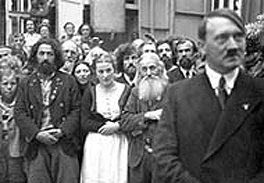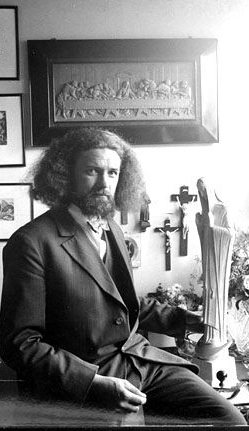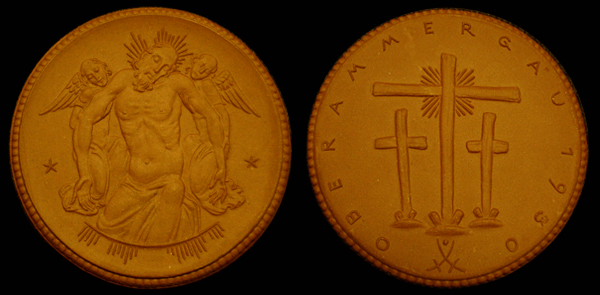
STADT OBERAMMERGAU (GERMAN) 1930
Town of Oberammergau (Bavaria) - Large Porcelain Medal Depicting Christ with Angels and Crosses.
This is a medal issued in 1930 by the German city of Oberammergau. On the obverse is a depiction of Christ supported by two angels. On the reverse is the city name, the date, three crosses and crossed swords. The swords are the trademark of Meissen porcelain works. Meissen produced a wide variety of attractive coins and medals in both earth toned and white porcelain.
Oberammergau is a small German town of just over 5,000 people located in the Ammer Valley. The town is surrounded by mountains, meadows and forests near the Alps in Bavaria. It is best known for its production of the Passion Play every ten years. The town is also well known for its woodcarving and the traditional Bavarian and religious scenes painted on the facades of many of the buildings known as Luftmalerei (pictured below). It has been the location of a NATO training school since 1953
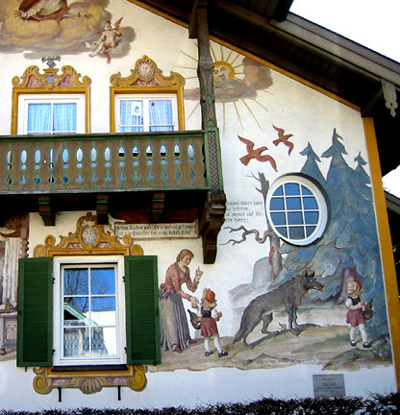 |
It began in the middle of the Thirty Years’ War, German towns and cities were devastated and suffered high casualties during the numerous conflicts. To make matters worse the plague was spreading across Europe and Germany was hard hit by the epidemic. Legend states that when thetown of Oberammergau was hit rather hard by the plague, they vowed that if God were to spare them, they would perform the Passion Play every ten years.
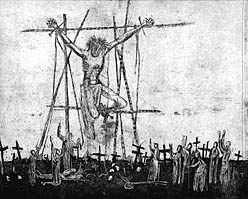 |
"in the large disappointment, which had brought the terrible illness over the municipality, finally the superiors of the municipality, the six and twelve, met and the vow was made to hold the passion tragedy every ten years and from this time on not one more person died, although still some suffered from the plague." |
The first play was performed in 1634 by 60 to 70 actors on a stage erected over the fresh graves of recent victims of the Black Death. This location was used for all consecutive plays until 1820. The town was not spared the plague though it is reported that, at least for a time, deaths became less frequent or halted all together.
The town believed they were spared because of the play they performed and fulfilled its vow to God. With few exceptions they have performed the passion play on the last year of each decade ever since. At this writing, the most recent performance was in 2010 and the next will be performed in the year 2020. The play is performed repeatedly through the year and can last up to seven hours.
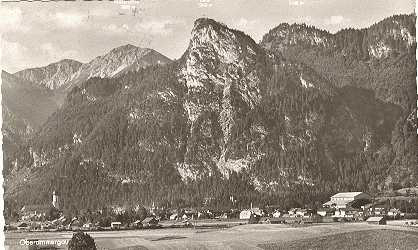 |
The town of Oberammergau surrounded by towering mountains |
Due to post war turmoil and economic instability the play was not performed in 1920. The play was instead performed in 1922 during a short period of what seemed to be an economic recovery. It turned out to be shortly before the almost total collapse of the German economy. The play had become quite a profitable enterprise by then and 1922 saw a drastic increase in attendance with more than 300,000 spectators, roughly 100,000 of these coming from outside Germany.
Larger crowds meant larger profits as the town has charged to watch the play since 1790 and has even sold package tours with room and board included since 1870. Unfortunately most profits from the 1922 play were quickly wiped out along with most peoples life savings during hyperinflation and the resulting devaluing of the Reichsmark and introduction of the Rentenmark in 1923.
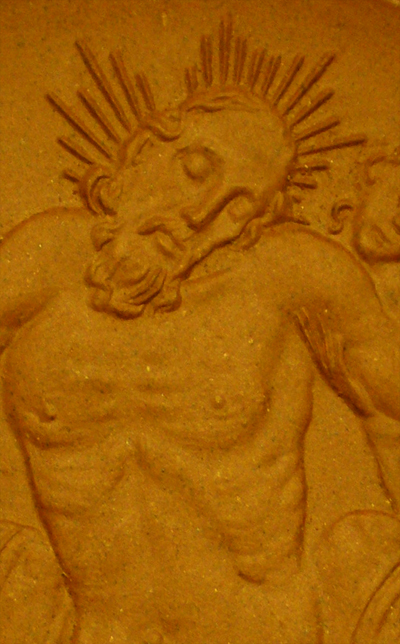 |
The Porcelain medal above was minted to commemorate the Passion Play of 1930 or the 32nd Passion Play year. It would be performed twice in this decade as the 33rd Passion Play year occurred in 1934 in honor of the 300th anniversary of the vow.
With the Impending anniversary in 1934 and an economy on the upswing, the play was transformed into a much more professional production in 1930. Using modern theatrical techniques for the first time on a new, larger stage in an expanded theater with a capacity of over 5,000 people each production. Since 1930, the number of yearly visitors has ranged from 420,000 to 530,000. |
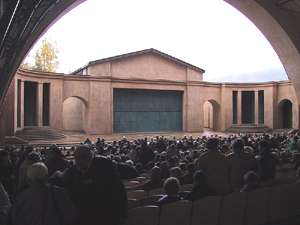 |
The Passion Play of 1930 was a bigger, grander affair with more than 420,000 spectators. Henry Ford attended and was so impressed with the acting talents of Alois Lang who portrayed Christ, he gave him a new car. One other famous spectator attended the play that year, it was a man whose rising fortunes and fate would soon be tied to that of the whole nation:
|
"At a show in August a man with a pale face, brown-reddish hair and a small moustache on the furrow of the upper lip sat in the passion theatre. He carried a trench coat and was accompanied by some men. After the play his friend Helene Bechstein brought him in the publishing house where he was introduced and invited for tea. {...} The man was called Adolf Hitler." |
Anti-Semitism in Germany was nothing new. As far back as the first crusades Jews were often characterized as 'Killers of Christ'. Thousands died when it was decided that before marching off to fight in the holy land, they should rid themselves of the Jew who was more abhorrent than the Mohamedian and lived amongst them. Anti-Semitism was not uncommon in Germany but it had been on the rise for some time in post World War I Germany. Unflattering depiction of Jews was widespread, on posters, in publications, and even on local currency notes.
By 1930 the Nazi party was on the rise when Hitler came to Oberammergau. By the time he again attended the play on the anniversary performance in 1934, he was the 3rd president of the Weimar Republic. He was a fan of the play and was inspired by the character of Pilate whom Hitler exalted by commenting:
"It is vital that the Passion play be continued at Oberammergau; for never has the menace of Jewry been so convincingly portrayed as in this presentation of what happened in the times of the Romans. There, one sees in Pontius Pilate a Roman racially and intellectually so superior that he stands out like a firm, clean rock in the middle of the whole muck and mire of Jewry."
Hitler had an interest in Oberammergau and its Passion Play but he wanted it done his way once he was in power. He appointed a High Commissioner for Tourist Traffic and ordered him to preside over the Passion Play committee. He would insure the play served the best interest of the Party and conformed to the new vision of a new, racially pure Germany. Hitler not only liked the figure of Pilate but he also liked to see Jews depicted as villains.
The Passion Play had already been condemned by many for being anti-Semitic. Many Jews have always had a distaste for this play that depicts them as the villains. Many have argued that the play depicts Jews as a blood thirsty, swarming, hateful mass, clamoring for the death of Christ. In fact it depicted several hundred frenzied Jews demanding that Jesus be put to death, crying out what has come to be called the "blood curse": "His blood be upon us and upon our children!" This is a direct condemnation of the Jew as the killers of Christ and their descendants are just as guilty of the sins of their forefathers.
Post World War II, Post Nazi Holocaust, there has been a stronger movement by Jewish groups to pressure the town to temper what they see as a decidedly anti-Semitic message. To many, especially in Oberammergau, it is sacrosanct, thus the council that oversees the production has historically been resistant to change.
All the same, through a series of rewrites to the script, the town has made an effort to compromise. Others simply see the story itself as essentially anti-Semitic in nature and believe it cannot be made otherwise and still be true to the source material. However you write and rewrite it, In the end the story is the same. It is the Jews who could have set Jesus free but they chose to let him die an agonizing death on the cross.
Those who defend the play see it simply as a re-enactment of a pivotal event in Christendom. It is a story and like most stories there are villains, sometime Persian, sometimes Roman or Egyptian. In history many different groups have played the villain. They insist the intent of the Passion is not to vilify the Jews but to glorify Christ and his labors.
The play presents the betrayal by Judas, the death sentence passed by Pontius Pilot after the Jews choose to save Barrabas over Jesus, and the persecution and crucifixion of Christ. It comprises spoken dramatic text, musical and choral accompaniment as well as scenes from the Old Testament depicted for the audience by motionless actors accompanied by verbal description.
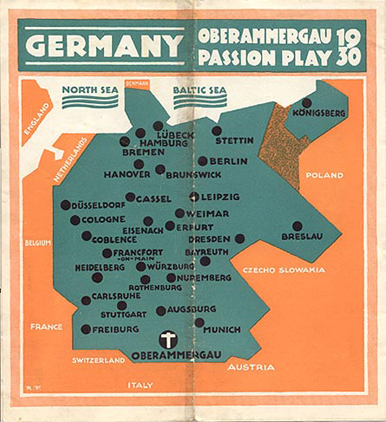 |
The play is a part of us. It controls the rhythms of our life, like it or not. |
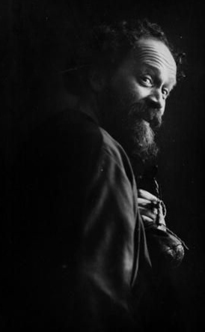 |
Most start as children and many participate their whole life. It is not uncommon for a person (or a whole family) to participate in their first ten years of life up to the last ten years and every decade in between. At a ceremony in September, the citizens reaffirm their ancestral vow to stage the play and veteran players are honored for a lifetime of participation. Months before the first production of the year, towns people begin to let their hair grow and the men stop shaving their beards. No makeup, wigs or artificial lighting are used. All actors, musicians, singers, costumers, and stage technicians are amateurs who work and rehearse in the evenings after work for almost a year. Planning for the next play begins years in advance and much of the town makes or sells religious themed goods made by the towns traditional craftsmen and artisans. Left: Guido Mayr, a woodcarver by trade, played the villain Judas for the second time in 1930 |
Although all performers are amateurs, they take the parts they play very seriously. They strive to not just depict the character they are playing but to become them. Those who play major roles often do so after demonstrating ability by consistently performing, and performing well, in lesser roles. It also has political elements as votes are cast and players are elected to the roles they are to play.
1930 saw a change in what is probably the most coveted role, that of Jesus Christ. Anton Lang (left), the aging but popular veteran to the role, was replaced in favor of his 38 year old understudy (and distant relative) Alois Lang. A potter by trade, Anton played Christ in the Passion Play three times. He played the role first in 1900, and was elected to the part again in 1910. His final performance was in 1922 to record crowds. |
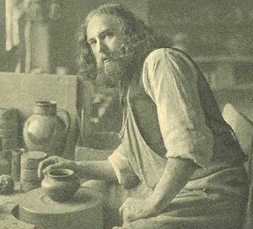 |
|
Alois is tall, robust, and 38 years old. In 1922 he lost the election to play Jesus by only a few votes, thereafter he understudied Anton Lang. He is elegantly mannered, confident, and magnetic. He keeps 40 hives of bees, likes to smoke and drink beer with the Apostles at the Hotel Alte Post. A woodworker by trade he carves innumerable wooden Christs, and exhibits no false modesty about his exalted position in the Passion Play. No one is happier in Oberammergau than his stout, simple wife, who might easily be mistaken for his mother. Some villagers will tell you that the hair of Alois Lang owes its luxuriant curliness to a permanent wave. |
The director of the play in 1930 was Johann Georg Lang. A forty year old teacher of woodcarving who is unrelated to either Alois or Anton Lang. Lang is a very common name in the area, there are an estimated 200 Langs in Oberammergau.
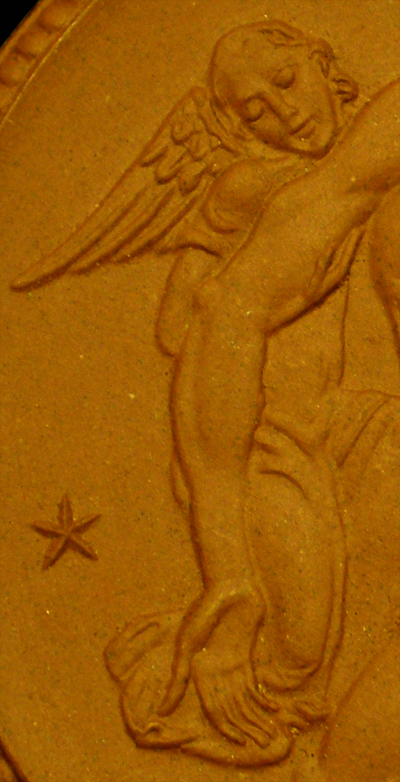 |

